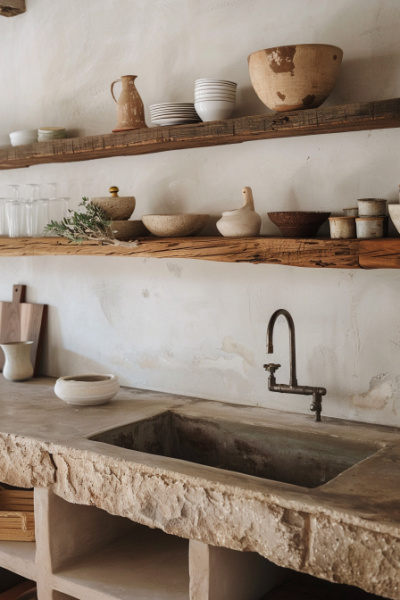18 Wabi-Sabi Kitchen Interior Ideas You Will Love! (Concept Designs)
Wabi-sabi is a Japanese worldview of an aesthetic perception wherein there is beauty in incomplete and transient things. This philosophy touches so much more than just on interior design; it gives a whole new perspective of how to relate to home lives and home spaces. It’s the invitation to stop running after the perfect setting of home and start receiving the quiet harmony which comes from just accepting the way things are.
These 18 wabi-sabi kitchen ideas are 18 kitchens telling a story beyond the shiny facade, common to all the mainstream designs. All these spaces have nothing to do with the latest gadget or the flawless marble counter but are in fact a tribute to the quirky, handcrafted, recycled, and repurposed.
It is all about letting the natural elements, calm colors, and textures with gentle scars of time become the heroes, allowing a tactile and visual feast that is authentic and deeply personal.
Every idea in this collection is a canvas on which life unfolds: one countertop, stained by a thousand spills, one table, scarred by a family craft project, one set of cabinets that remembers the touch of a thousand hands. These are kitchens designed for looking, but they are for so much more.
10 key elements when decorating your wabi-sabi kitchen:
- Handcrafted ceramic dinnerware set
- Natural linen kitchen towels
- Bamboo cutting boards
- Stone pebble mosaic backsplash tiles
- Rustic wooden floating shelves
- Woven rattan dining chairs
- Hand-blown glass pendant lights
- Organic cotton table runner
- Vintage wooden spice rack
- Natural jute area rug
18 Wabi-Sabi Kitchen Designs
1. A Serene Space for Culinary Creation

Embrace the simplicity of earthen tones and textures in this kitchen that speaks to the soul of pastoral living.
2. Harmony in Materials: A Blend of Old and New

Discover a kitchen where modern functionality seamlessly fuses with the timeless allure of natural wood and ceramic.
3. Perfectly Imperfect: A Wabi-Sabi Kitchen Oasis

In this wabi-sabi kitchen, find beauty in the asymmetry and raw edges that tell a story of authenticity.
4. Handcrafted Elements for Inspired Living

Each element in this kitchen is a testament to the craftsman’s hand, from the wooden shelves to the pottery that graces them.
5. A Wabi-Sabi Kitchen with a Heart of Wood

Rich wooden textures and a sense of organic comfort define this wabi-sabi kitchen, where every meal feels like home.
6. Culinary Heritage Brought to Life

Step into a space where each dish is infused with history, surrounded by pottery that echoes the past.
7. Simplicity Reigns in This Wabi-Sabi Kitchen Sanctuary

Amidst the quietude of muted tones and natural materials, this wabi-sabi kitchen is a retreat from the world’s hustle.
8. Where Every Meal is a Masterpiece

In this kitchen, the robust wood and stone become the canvas for culinary artistry, inviting creativity at every turn.
9. Understated Beauty in a Wabi-Sabi Kitchen Design

Balance and peace flow through this wabi-sabi kitchen, where every object is chosen with intention and care.
10. A Nostalgic Whisper in a Modern World

This kitchen whispers tales of yesteryear, inviting you to create not just food, but memories in its embrace.
11. Echoes of Elegance in Abandonment

A wabi-sabi kitchen corner that tells a tale of time with its weathered walls and lovingly used utensils.
12. Natural Light and Simplicity

A space where minimalism breathes, highlighted by the soft light that dances across each carefully placed object.
13. The Essence of Wabi-Sabi Living

This kitchen embodies wabi-sabi philosophy, celebrating the beauty found in the marks of use and the patina of time.
14. Rustic Textures and Timeless Moments

Every corner is a still life in this kitchen, where rustic textures and muted colors create a tranquil culinary canvas.
15. Harvesting Serenity

A wabi-sabi tableau set for the quiet contemplation of nature’s bounty and the simple joys of cooking.
16. Monochromatic Harmony

Find solace in the monochromatic harmony and the silent stories that these walls and worn surfaces whisper.
17. A Study in Contrasts

Raw wood and smooth ceramics juxtapose to form a kitchen that’s as much a gallery as it is a place for gastronomy.
18. Textures of Tranquility

Textures tell the story in this kitchen, where every surface speaks to the wabi-sabi love of the understated and the aged.
Frequently Asked Questions
What is a wabi-sabi kitchen?
The kitchen wabi-sabi finds its design in a Japanese world outlook, which seeks beauty in imperfection and transience. It is usually a style of natural material; hence, the use of art and accessories with clear lines and works from artisans showing signs and patina of daily elements used and loved.
How can I incorporate wabi-sabi into my own kitchen?
Wabi-sabi your kitchen with natural material choices of wood and stone, handmade items displaying beautiful imperfections, and a quiet earthy color palette. Find beauty in wear and asymmetry over something new and perfect.
Are wabi-sabi kitchens expensive to design?
Designing a wabi-sabi kitchen can be a very expensive venture or, at its cheapest, cost-efficient, putting in mind the wabi-sabi values that mostly entail utilizing what one has in place of going out to purchase new and possibly more expensive items to replace the older, poorer ones.
How does wabi-sabi differ from minimalism?
Both regard the element of simplicity in their aesthetic values: whereas wabi-sabi values that which is rustic, imperfect, and aged, minimalism calls for reducing clutter to its essentials and often embraces clean modern lines.
Can wabi-sabi design be practical for a busy kitchen?
Absolutely the case for Wabi-Sabi, therefore; it was not only aesthetics but functionality. Indeed, marks of use are dear to them; hence, the feeling from a busy kitchen may actually even elevate the room in its sense of Wabi-Sabi, as objects gain character slowly from daily activity.
Is wabi-sabi suitable for families with children?
Wabi-sabi can be very suitable for a family raising a child. Admitting a family living in their home. The best choice will be using natural, solid, and resistant materials for its creation to resist the tangles in life.
How do I maintain a wabi-sabi kitchen?
A wabi-sabi kitchen is, after all, still a kitchen; therefore, standard cleaning and care have to be a part of the upkeep. The only thing that changes is the wear and tear of things that is now visible to add character to the kitchen rather than being corrected.
Can modern appliances fit into a wabi-sabi kitchen design?
Modern appliances come into the wabi-sabi kitchen but reconciled with thought. Most usually, they are either put away or incorporated into the design not to ruin the unforced, essential, rustic look.
What are common materials used in wabi-sabi kitchens?
Common materials would include unfinished wood, stone, clay, ceramics, and a host of other similar materials—all chosen in that they have natural imperfections which make them age with time in graceful unison.
How do I know if wabi-sabi is the right style for me?
If you love old things, their edges chipped, their shapes irregular, and if you place high value on objects that carry a story along with them, then you love wabi-sabi. It all has to do with the celebration of nature and allowing this natural cycle of growth and decay to establish authenticity.














